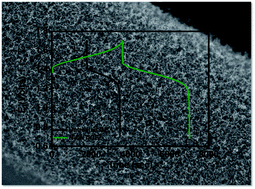High efficiency of bamboo-like carbon nanotubes on functionalized graphite felt as electrode in vanadium redox flow battery†
Abstract
Bamboo-like carbon nanotubes (B-CNT) were directly grown on graphite felt (B-CNT/TA-GF) by chemical vapor deposition for use as positive and negative electrodes in a vanadium redox flow battery (VRFB); the graphite felt was functionalized by acid activation and thermal treatment before the growth of B-CNT. B-CNT/TA-GF shows excellent activity and high reversibility in catalyzing the redox reaction of vanadium ions, in which the ratio of the redox peak current densities is close to 1 and the separation of the redox peak potentials is only 0.181 V. VRFBs using B-CNT/TA-GF show 81.0% energy efficiency, which is superior to those using untreated GF (68.3%), acid-treated GF (77.5%) and acid- and thermal-treated GF (76.1%). Thus, the VRFB using B-CNT/TA-GF yields a low iR drop, high efficiency, and high capacity, which may arise from its large surface area, large amount of oxygen functional groups, low internal resistance, favorable sp2 carbon content, and nitrogen dopant on the surface of the CNTs, all of which make the electrodes in a VRFB efficient.



 Please wait while we load your content...
Please wait while we load your content...